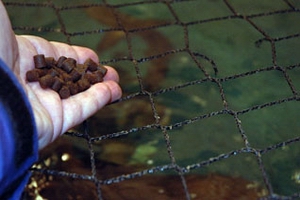 and demands for fishmeal in aquaculture production are leading researchers with NOAA and the USDA to explore alternative and more efficient fishmeal techniques, including stabilizing fish trimmings — an existing idea that may mature if the demand for fishmeal keeps going up.
and demands for fishmeal in aquaculture production are leading researchers with NOAA and the USDA to explore alternative and more efficient fishmeal techniques, including stabilizing fish trimmings — an existing idea that may mature if the demand for fishmeal keeps going up."Worldwide, about 25 percent of the fishmeal already comes from fish trimmings. Large fisheries, such as the whitefish fisheries in Alaska already have conventional fishmeal plants for their by-products. However, there is potential to get more fish trimmings meal from the smaller and shorter duration fisheries with new technologies" said Michael Rust, science coordinator for the office of aquaculture at NOAA Fisheries.
One of the challenges is gathering fish trimmings from all the small fish processors in very remote areas. "It doesn't make sense to put a conventional fishmeal plant [in those areas]. You would have to design a facility that runs 10 days a year," Rust said.
As a result, NOAA and USDA researchers are determining how to stabilize small fishmeal lots to be utilized in large aquaculture operations. "Fishmeal can be stabilized in the same way that yogurt is stabilized: by balancing its pH. Then, it becomes more shelf-stable so, in the case of yogurt, instead of it lasting two to three days, it can last two to three months. You can take the fish trimmings and turn that into fishmeal over three to four months," Rust said.
Working with salmon processors in Alaska, Rust and other researchers at NOAA's Northwest Fisheries Science Center tested fishmeal stabilization. They combined wet reduction technology, acid stabilization, and drum drying of fish waste. They added 0.8 percent formic acid to deboned and semi-processed fish meat, which allowed short-term storage. The stored, acidified material was able to be dried when capacity became available, allowing for more hours of operation to accommodate smaller production lines.
The process can handle various types of fish scraps to make into fishmeal. In experiments with trimming houses in California, NOAA researchers tested retrofitted machines to handle a wide variety of fish. "In California, they get an extreme variety of material in on a daily basis, including flatfish, salmon and rockfish. In their waste stream, it's difficult to handle a mixture that changes composition so frequently. They need something that can handle 3,000 pounds per day of a variety of inputs, and still get a consistent output" Rust said.
The machines were retrofitted from different industries. For example, the drum dryer was used by a chocolate manufacturer in Pennsylvania, and the researchers made slight modifications to use with stabilized fish.







